外研版三年级下册英语教案
- 格式:doc
- 大小:203.50 KB
- 文档页数:21
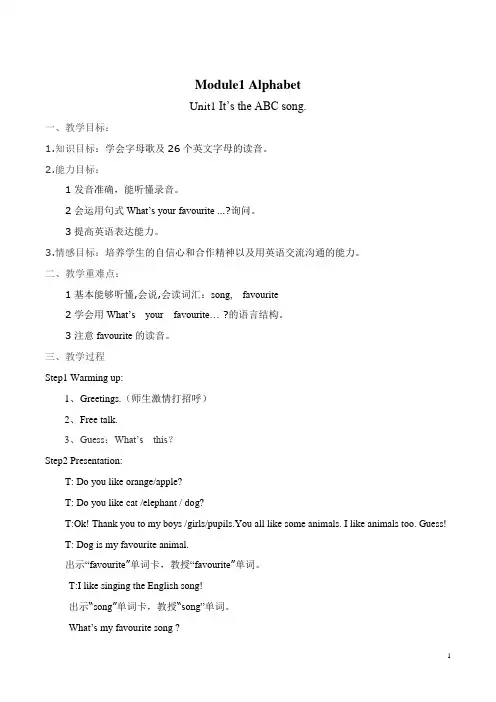
Module1 AlphabetUnit1 It’s the ABC song.一、教学目标:1.知识目标:学会字母歌及26个英文字母的读音。
2.能力目标:1发音准确,能听懂录音。
2会运用句式What’s your favourite …?询问。
3提高英语表达能力。
3.情感目标:培养学生的自信心和合作精神以及用英语交流沟通的能力。
二、教学重难点:1基本能够听懂,会说,会读词汇:song, favourite2学会用What’s your favourite… ?的语言结构。
3注意favourite的读音。
三、教学过程Step1 Warming up:1、G reetings.(师生激情打招呼)2、F ree talk.3、G uess:What’s this?Step2 Presentation:T: Do you like orange/apple?T: Do you like cat /elephant / dog?T:Ok! Thank you to my boys /girls/pupils.You all like some animals. I like animals too. Guess!T: Dog is my favourite animal.出示“favourite”单词卡,教授“favourite”单词。
T:I like singing the English song!出示“song”单词卡,教授“song”单词。
What’s my favourite song ?It’s the ABC Song.What’s the ABC song ?一体机播放视频the ABC song。
采用不同的方式巩固新单词:开火车猜口型你大我小等,让学生读的准,说的准。
教师及时给予公正的评价,同时注意学生的发音,及时纠正错误。
巩固练习:T:What’s your favourite song ?S1:It’s the ABC Song.S2:It’s the…Song.设计意图:教师创设情境,呈现新单词和句型,学生在教师的引领下学习语言。
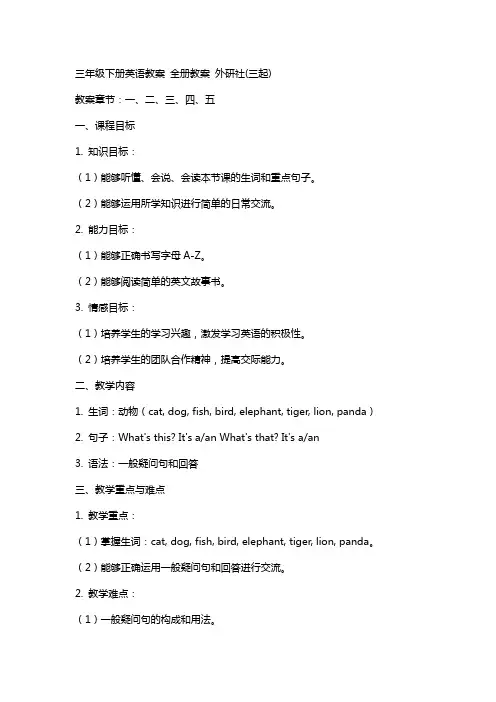
三年级下册英语教案全册教案外研社(三起)教案章节:一、二、三、四、五一、课程目标1. 知识目标:(1)能够听懂、会说、会读本节课的生词和重点句子。
(2)能够运用所学知识进行简单的日常交流。
2. 能力目标:(1)能够正确书写字母A-Z。
(2)能够阅读简单的英文故事书。
3. 情感目标:(1)培养学生的学习兴趣,激发学习英语的积极性。
(2)培养学生的团队合作精神,提高交际能力。
二、教学内容1. 生词:动物(cat, dog, fish, bird, elephant, tiger, lion, panda)2. 句子:What's this? It's a/an What's that? It's a/an3. 语法:一般疑问句和回答三、教学重点与难点1. 教学重点:(1)掌握生词:cat, dog, fish, bird, elephant, tiger, lion, panda。
(2)能够正确运用一般疑问句和回答进行交流。
2. 教学难点:(1)一般疑问句的构成和用法。
(2)生词的准确发音和书写。
四、教学方法与手段1. 教学方法:(1)情境教学法:通过设置生活情境,让学生在实际语境中学习英语。
(2)游戏教学法:通过趣味游戏,激发学生的学习兴趣。
(3)任务型教学法:通过完成具体任务,培养学生的实际应用能力。
2. 教学手段:(1)多媒体教学:利用课件、动画、音频等手段,提高教学效果。
(2)实物教学:使用实物道具,帮助学生直观地理解和学习。
五、教学步骤1. 热身活动(5分钟)(1)唱英文歌曲:Hello, Hello, Hello!(2)老师出示动物卡片,学生模仿动物声音和动作。
2. 引入新课(10分钟)(1)老师出示动物图片,引导学生说出动物名称。
(2)讲解一般疑问句的构成和用法,让学生练习提问和回答。
3. 课堂活动(15分钟)(1)分角色扮演,让学生练习一般疑问句的问答。

【导语】英语教案设计是改善课堂教学的⼀种更⾼层次的探索,是提⾼课堂教学质量和效率的⼀项必要⼯作,它可以促进教学的系统化,使⽼师掌握讲课节奏。
以下是⽆忧考为您准备的与(外研版英语三年级下册【三篇】优质教案)相关的资料,希望可以帮助到您!【篇⼀】 Teaching points: Grasp the important words and phrases. ⼀、Warming up: 1. Greeting: T: Hello, boys and girls. Let us recite the seasons. Ok? Ss: Ok. T and Ss: spring, summer, autumn and winter. T: What day is it today? Ss: Today is …… 2. Saying a chant: Hello, Meg, hello, Ted. What’s his name? He is Ben. What’s her name? She is Pat. How old is she? She is eight. How old is he? He is nine. 3. Singing “Head, shoulders, knees and toes. ⼆、New concept. T: Oh, you are great .Today let us learn Module 6Activities Unit 1 What do you do at the weekend? (Writing and reading) 1. T: Do you like playing football? Ss: Yes, I do. T: What do you do at the weekend? (explain in Chinese ) Ss: I play basketball. T: I like reading at the weekend .What about you? Ss: I like swimming. T: You are great. T: And what do you have at school? You can say: I have …… Ss: I have English and Chinese. T: Do you like maths? Ss: Yes, I do. / (No, I don’t.) T: What do you do at 5 o’clock in the morning? I sleep in the morning. What about you? Ss: I sleep too. 2. Do exercises: On the board write the following list 1) What do you do at the weekend? I……….. 2) What do you have at school? I have …… and …… 3. Listen and say. Play the tape, pause it after each utterance and let the Ss repeat the sentences. 4. Show the Ss some books .For example “Maths” “Chinese” “Science” Show the Ss some pictures “football” “sleep” “swimming 5. Text 1) Listen and look. 2) Answer questions: What do you do at ……o’clock in the morning? What do you have at school? 三、Homework: 1) Read the text frequently and recite the text. 2) Copy the following sentences 2 times. What do you do at the weekend? What do you have at school?【篇⼆】 教学重点:words and phrases: half, past, have breakfast / dinner 教学难点: What’s the time,please? It’s half past six. I have breakfast at half past six. 热⾝复习: ⽼师出⽰6个动词词组,学⽣读,并说出每个词组的意思。
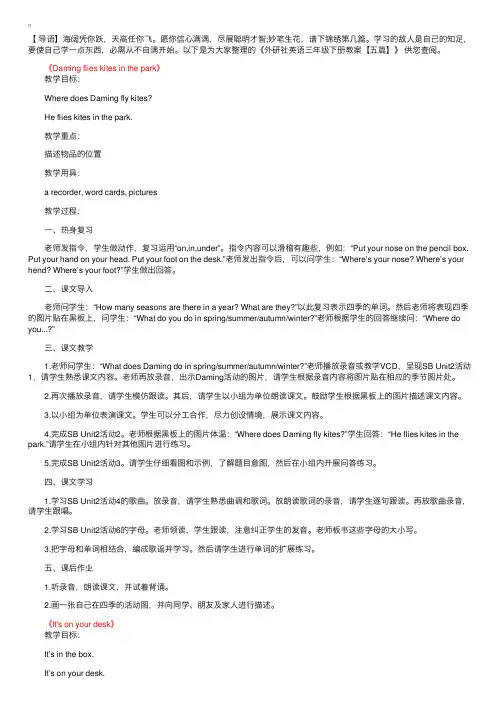
【导语】海阔凭你跃,天⾼任你飞。
愿你信⼼满满,尽展聪明才智;妙笔⽣花,谱下锦绣第⼏篇。
学习的敌⼈是⾃⼰的知⾜,要使⾃⼰学⼀点东西,必需从不⾃满开始。
以下是为⼤家整理的《外研社英语三年级下册教案【五篇】》供您查阅。
《Daming flies kites in the park》 教学⽬标: Where does Daming fly kites? He flies kites in the park. 教学重点: 描述物品的位置 教学⽤具: a recorder, word cards, pictures 教学过程: ⼀、热⾝复习 ⽼师发指令,学⽣做动作,复习运⽤“on,in,under”。
指令内容可以滑稽有趣些,例如:“Put your nose on the pencil box. Put your hand on your head. Put your foot on the desk.”⽼师发出指令后,可以问学⽣:“Where’s your nose? Where’s your hend? Where’s your foot?”学⽣做出回答。
⼆、课⽂导⼊ ⽼师问学⽣:“How many seasons are there in a year? What are they?”以此复习表⽰四季的单词。
然后⽼师将表现四季的图⽚贴在⿊板上,问学⽣:“What do you do in spring/summer/autumn/winter?”⽼师根据学⽣的回答继续问:“Where do you...?” 三、课⽂教学 1.⽼师问学⽣:“What does Daming do in spring/summer/autumn/winter?”⽼师播放录⾳或教学VCD,呈现SB Unit2活动1,请学⽣熟悉课⽂内容。
⽼师再放录⾳,出⽰Daming活动的图⽚,请学⽣根据录⾳内容将图⽚贴在相应的季节图⽚处。
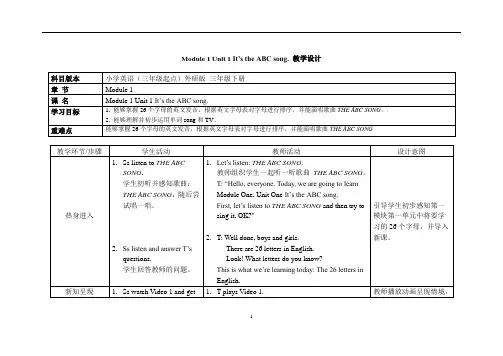
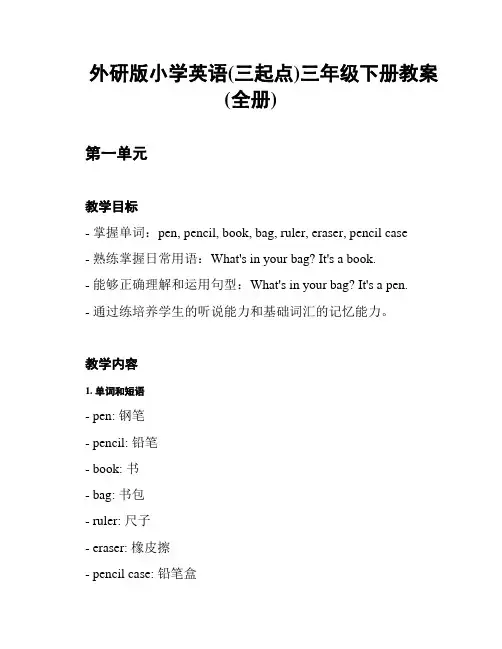
外研版小学英语(三起点)三年级下册教案(全册)第一单元教学目标- 掌握单词:pen, pencil, book, bag, ruler, eraser, pencil case- 熟练掌握日常用语:What's in your bag? It's a book.- 能够正确理解和运用句型:What's in your bag? It's a pen.- 通过练培养学生的听说能力和基础词汇的记忆能力。
教学内容1. 单词和短语- pen: 钢笔- pencil: 铅笔- book: 书- bag: 书包- ruler: 尺子- eraser: 橡皮擦- pencil case: 铅笔盒- What's in your bag?: 你的书包里有什么?2. 句型- What's in your bag? It's a pen.: 你的书包里有什么?是一个钢笔。
教学步骤1. 导入新知- 通过展示相关图片或实物,向学生介绍新学的单词和短语。
读几遍单词,让学生跟读。
2. 研究新知- 引导学生边听边读单词和短语。
师生互动,让学生理解词义。
- 模仿老师的提问,让学生回答"What's in your bag?"的问题,然后用"It's a pen."来回答。
3. 基础练- 让学生分组,互相询问"What's in your bag?",并用"It's a..."来回答。
4. 巩固练- 给学生发放练册,让学生完成相关练题。
- 老师巡视课堂,确认学生的练情况。
5. 综合运用- 制作一份课堂道具箱,里面放入各种与单词和短语相关的物品,如钢笔、铅笔、书等。
- 让学生一个接一个地从道具箱里取出物品,并回答"What's in your bag?"的问题和对应的答案。
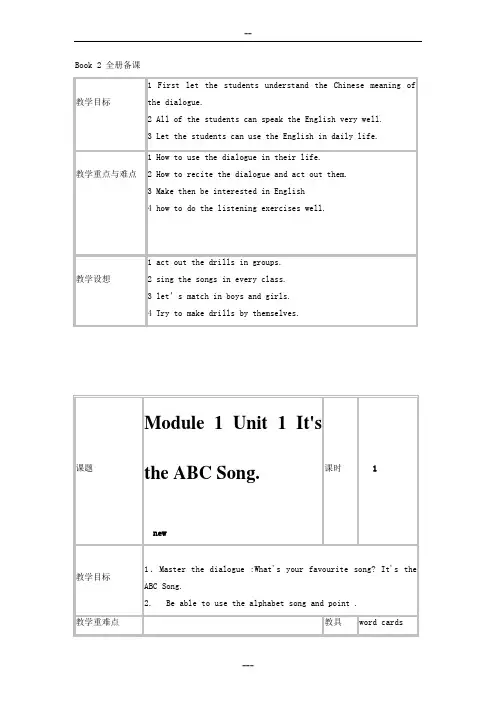
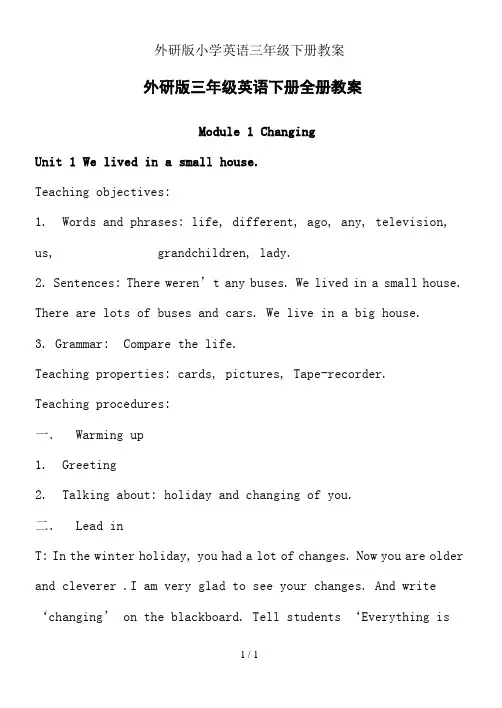
外研版三年级英语下册全册教案Module 1 ChangingUnit 1 We lived in a small house.Teaching objectives:1. Words and phrases: life, different, ago, any, television, us, grandchildren, lady.2. Sentences: There weren’t any buses. We lived in a small house. There are lots of buses and cars. We live in a big house.3. Grammar: Compare the life.Teaching properties: cards, pictures, Tape-recorder.Teaching procedures:一.Warming up1. Greeting2. Talking about: holiday and changing of you.二.Lead inT: In the winter holiday, you had a lot of changes. Now you are older and cleverer .I am very glad to see your changes. And write‘changing’ on the blackboard. Tell students ‘Everything ischanging. No change, no progresses.三.New teaching1. Show some old photos and say: Look, life was very different many years ago .But how was it different? Today, we will learn how to compare past and present life.2. Listen to the tape and underline the new words.3. Teach the new words.a. Show some new word cards.b. Correct pronunciation.c. Practise new words in different kinds of method.d. Explain important phrases.4. Listen to the tape-recorder and read follow it .5. Act out text.四.Practise1. Pay attention to SB unit1 part2 and copy them to make sentences.2. Show some pictures. Make some students find differentin them and describe in English.五.Summary and homework.1. SummaryT: Today we have learnt “How to describe past and present life, review simple past tense and present tense.”2. Today’s homeworka. Listen and read Unit1 three times, try to recite and act.b. Compare two photos and write differences.Designs:Module 1 ChangingUnit 1 We lived in a small house.weren’t lived smallare live big新标准英语三年级起点第六册教案Module 1 ChangingUnit 2 She didn’t have a television.Teaching objectives:1. Word and phrases: fire, radio, telephone, field, hope.2. Sentences: She worked in the fields. She didn’t have atelevision.3. Grammar: Talk about the life of past and now.Teaching procedures:一.Warming up.1. Greetings.2. Act out last text.3. Free talk: Compare ‘Old China and New China.’二.Lead inYesterday, Lingling saw the programme about China, she missed her grandmother very much. So she writes a letter forDaming, tells about that programme and her feeling.三.New teaching.1. Show some questions.a. What programme did Lingling watch last night?b. What was the old lady’s life like many years ago?c. Who does Lingling miss?2. Listen to the tape-recorder and find answers.3. Learn new words.a. Show some object and cards.b. Correct pronunciation.c. Practise new words in different kinds of method.4. Listen to the tape-recorder and act out it.四.Practise1. Play a game.Put nine cards on the desk. Two students use cards to make dialogue. For example:A: Where was he/she seven days ago?B: He/She was …A: What did he/she do there?B: He/She …2. Do A B Unit 2 exercise1.a. Listen to the tape.b. Understand generalization.c. Choose right answer.五.HomeworkIntroduce the great changes of our hometown/school/home.新标准英语三年级起点第六册教案Module 2 GrandparentsUnit 1 She learnt English.一、Teaching objectives:1. Words and phrases: learnt these dancer2. Sentences: She learnt English.Did she learn any foreignlanguages. He is learning English now.3. Grammar: Talking about the past and present.4. Teaching properties: word cards photos tape.二、Teaching procedures.一、Warming—upGreeting:T: Hello, Good morning, class. S: Good morning, teacher. T: How are you today? S: We are well.T: What day is today? S: Thursday.T: Are you ready for your English class? S: Yes. We are ready. Game: Review the past tense of some verbs.二、New teaching1. Use some pictures to learn important sentences.Did you/h e /she …..? Yes, I/she/he did. No, didn’t.He is doing …….2. Learn new words and phrases.Teacher plays the tape and have Ss underline th e new words and phrases. Teacher guides to learn by all kinds of methods.3. Listen and repeat4. Act out the test. (Give Ss some minutes to practise.)三、Practice and consolidate.1. Show two pictures and have Ss describe (use the important sentences)2. Do activity3.Have Ss look it , give some minutes to practi se in pairs ,then act it out.四、Task—fulfillingGame :teacher have Ss take out their photos and descr ibe it. The others guess it.五、Sum the lesson六、Homework:Try to describe the other persons to your parents.新标准英语三年级起点第六册教案Module 2 GrandparentsUnit 2 Mr Li was a teacher.一.Teaching objectives:1. Words and phrases: study hard retired2. Sentences: Mr Li was a teacher. He taught Chinese.Chen Hai is an English teacher. He’s teaching Mr Li.3. Grammar: Talk about the past and the present. 二.Teaching properties: word cards\ Pictures\tape 三.Teaching procedures:一、Warming—up1.Greeting : Free talk2.Game: “What did he do?”二、New teaching1. Lead---inTeacher has a student stand in the front of t he class.T: Ten years ago ,I was a student .Now,I am a teachet. Ok, let’s come to the text.2. Important words and sentences①Listen and underline the new words. Teacher uses all kinds of methods to guide.②Show some pictures and let Ss describe them.③Listen and repeat3. Practice in pairsShow a pictureof sports player .Have Ss say out the differences between the pictures.(use the important sentences) Show three pictures and have Ss compare.4. PronunciationHave Ss listen and repeat. Put these words on the Bb. Let them find the similar pronunciation. Follow the tape two times.5. Say a poemLook. Listen and follow the tape. Then say together with actions.三、SummaryHave Ss sum this lesson. Teacher gives complement.四、HomeworkWrite the mutation in your life.新标准英语三年级起点第六册教案Module 3 English FoodUnit 1 She had eggs and sausages一、Teaching objectives1、Words and phrases: email sandwiches traditional delicious2、Sentences: What did she have for breakfast/lunch/dinner?She had…3、Function: Describing eating habits二、Teaching tools: card Tape-recorder pictures三、Teaching procedures:1、Warm up:T: Hello, boys and girls.S: Hello, teacher.T: What’s your favourite food?S: My favouri te food is…2、Presentation:T: I had bread this morning, what did you have?Ss: I had rice/milk/noodles…T: We always have rice, noodles, and dumplings for meals. They are Chinese food. Do you know English food?Ss: Talk about English food which they know.T: Tell the student Daming get an email from Lingling. It’s talk about English food. Now let’s see what Lingling introduces. Then write the title.四、Teach new lesson:Step1 Show them some new word cards and teach them the pronunciation. Step2 Open their books; listen to the tape for the first time, ask the students to find out the new words and the name of the food.And explain some English eating habits.Step3 Give the student some questions:1、What did Daming have got?2、What did Lingling have for breakfast/lunch/dinner?Listen to the tape for the second time, ask the students to answer the question, and then check the answer together.Step4 Ask the students to see the pictures and play the tape, the students read after it. At last the students read the text in pairs.五、PracticeAsk the student to see the third part of the text. Use the sentences to make dialogues in pairs.六、HomeworkGo over the text. Pay attention to the important sentences and the name of the food.新标准英语三年级起点第六册教案Module 3 English FoodUnit2 Sam ate six hamburgers一、Teaching objectives:1、Words and phrases: ate hamburger gave tonight2、Sentences: What did you eat/drink last night?I ate/drank…3、Function: Talk about eating habits and favourite food二、Teaching tools:三、Teaching procedures:1、Warmer:T: Hello.Ss: Hello teacher.T: What did you have for breakfast this morning?Ss: I had…T: What’s your favourite food?Ss: My favourite food is…3、Presentation:Take out a picture of hamburger and ask the students “Do you like hamburger?” “How many hamburgers can you eat? Students answer the questions. T: Let’s see how many hamburgers Sam can eat. Then write the title on the board.4、Teach new lesson:Step1 T: Take out some new word cards. Ask students to try to read out them, and then teach them these words.Step2 Put on a letter of this unit. Ask students to see the letter and at the same time to listen to the tape. For the first time the students should draw a line under the new words. Then ask them to try to answer these questions:1、Who ate hamburgers?2、Who had a sandwich?3、What is mum going to cook tonight?Step2 Play the tape, the students should read after it. Then check the answers.Step3 Ask the students to see the second part. Use the food to make some dialogues. Students do it in pairs. To see which group is the best.Step4 Game将全班分成几组,教师出示有关食物的卡片,要求学生看到食物后马上造句,哪组有一名学生先站起来,就算哪组先抢达到。
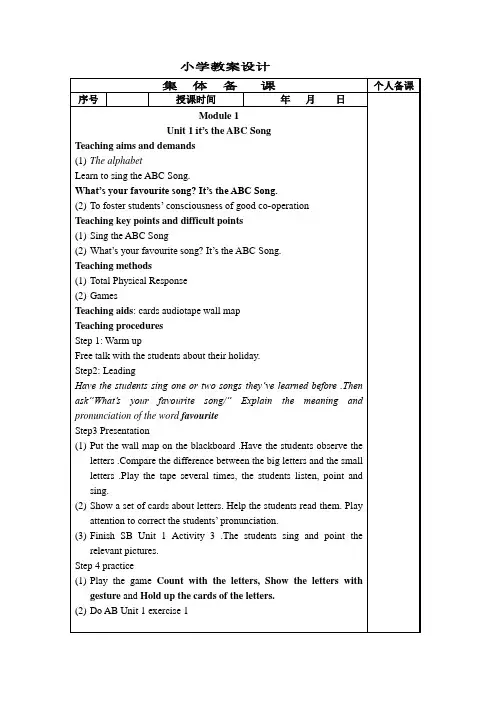
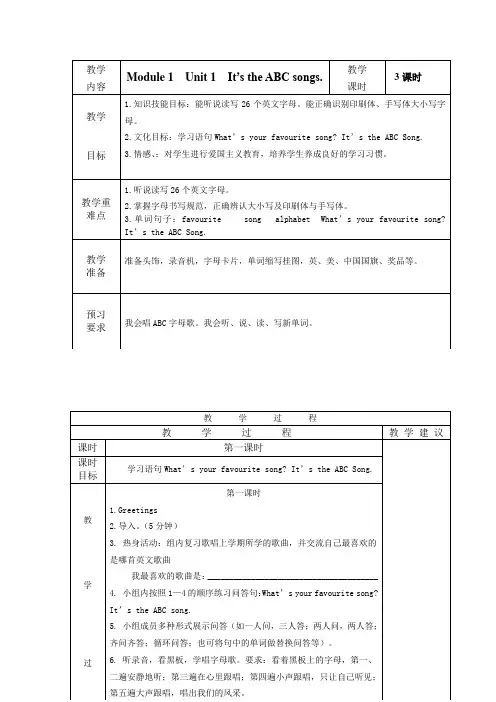
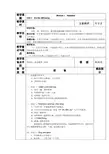
外研版三年级下册英语教学计划(通用5篇)外研版三年级下册英语教学规划篇1本学期我连续担当三年级英语的教学工作,以下为本学期英语外研版三年级下册的教学规划。
一、学情分析三年级共有六个班,我所带的班级是三年级(三)班,共36名学生。
经过一个学期的牛津英语和新标准英语的学习,大局部学生已经适应两种英语教材的教学模式。
但教师任需要在开课前给学生传达新课本的大纲、要求和目标。
认真阅读前言,并且带着学生扫瞄一遍课本,使学生对新课本有肯定的了解,从心里慢慢承受喜爱上新教材。
同时介绍新课本的分布及也许的重难点地方。
重点工作放在英语表达力量的培育,常规的建立和兴趣的建立。
作为一名英语教师,更应当激发学生连续保持学习英语的兴趣,在学习学问点的同时,能够渗透英美文化,学习和区分中西文化的差异。
本学期仍旧是外研版英语教材和上海牛津英语齐头并进,结合外研版和牛津版教材来完本钱学期的教学任务,凸显我们学校的这一特色。
二.教材分析新标准英语教材共10个模块,一个复习模块。
每个模块分两个单元。
一般状况下,第一单元呈现本模块所要学习的语言内容,其次单元供应若干任务型活动,包括一首歌曲、歌谣或韵句。
学习模块的课文中消失了一些语法内容,但不要求学习孤立地、脱离语境地把握,只语境中运用包含这些语法的句子。
主要内容包括:26个字母学习及我最喜爱的物品;名词单复数变化及用反义词描述的句子;运动工程及表述喜好的工程;食物及询问与答复本人或他人宠爱的食物;中西方重要节日春节,元旦,圣诞节等;四季及描述天气的简洁句型;Has引导的疑问句和交通工具的学习;方位介词及固定搭配。
即:话题——功能——构造——任务。
牛津版版教材: 3B的教材包含了4个模块,共12个单元。
新授单元由这几个板块组成:Listen and say 中的句型是每个单元的教学重点。
Look and learn,主要呈现词汇。
Say and act是情景对话板块。
该板块通过情景会话,着重训练学生的听说技能,提高会话力量。
Module 1 Unit 1 It’s the ABC Song教学目标:知识目标:学会英语歌曲及26个字母的发音。
能力目标:1.能听说读26个英文字母。
2.能正确识别印刷体、手写体大小写字母。
情感目标:对学生进行爱国主义教育,培养学生养成良好的学习习惯。
教学重点:1、听说读写26个英文字母。
教学难点:1、掌握字母书写规范,正确辨认大小写及印刷体与手写体。
教学用具:Word cards, PPT, CD-ROM and headwear, etc.教学过程:Step 1、Warm up and revision1.GreetingSing songs: “Good morning, Sam” and“ How are you?”2.自由会话(D—David,让学生做小先生,以下为David与同学们的对话)Dialogue 1:T:Good morning, what’s your name ?D:Hello,my name is David.D-a-v-i-d.(同时书写)I'm 12.Nice to meet you.Ss:Nice to meet you, too.D:This is Miss Wu,my English teacher.T:Nice to meet you.Ss:Nice to meet you, too.Dialogue 2:D:Look,What's this in English?(Show pictures of a cat on the PPT)S1:A cat.D:Spell it,please.S1:Yes,c-a-t,cat.D:What colour is it?S2:Black.Dialogue 4:D:Let's count from 1 to 20,OK?Ss:OK.(Boys 1,3,5…Girls 2,4,6… Clap hands from 1 to 10.Stamp feet from 11 to 20.)(拍拍手跺跺脚)Step2: Lead inHave the students sing one or two songs they’ve learned before .Then ask”What’s yourfavourite song?” Expla in the meaning and pronunciation of the word favourite.Step 3、Learn new knowledge1.T: Look at the 26 letters on the blackboard, let’s read them together!(在黑板上写Module 1,挂上字母表,让学生逐个跟读字母。
外研版三年级起点三年级英语下册全册教案Unit 1: My School LifeLesson 1: Hello, My Friends- Objectives:- Introduce basic greetings: hello, hi, goodbye- Recognize and say the names of classmates- Learn the question "What's your name?" and answer with personal names- Teaching steps:1. Warm-up: Greet students with different greetings and encourage them to respond accordingly2. Introduction: Teach students greetings such as hello, hi, and goodbye through gestures, expressions, and simple dialogues3. Group activity: Divide students into small groups and ask them to introduce themselves by saying "Hello, my name is [name]." Encourage them to ask each other's names using "What's your name?"4. Pair work: Have students practice the dialogue in pairs, taking turns to ask and answer the question "What's your name?"5. Consolidation: Play a name recognition game where students have to point to the person when their name is called out.6. Wrap-up: Recap the lesson by reviewing the greetings and names of classmates.Lesson 2: My Classroom- Objectives:- Learn vocabulary related to classroom objects: desk, chair, book, pencil, etc.- Practice using "This is" and "That is" to describe objects- Teaching steps:1. Recap: Review the greetings from the previous lesson and ask students to say their names again.2. Introduction: Show flashcards or real objects related to the classroom, such as a desk, chair, book, etc. Teach the vocabulary using visuals and gestures.3. Whole class activity: Hold up an object and say "This is a [object]." Have students repeat after you.4. Pair work: Divide students into pairs and give each pair various objects from the classroom. Students take turns describing the objects using "This is" and "That is."5. Consolidation: Play a game where students have to point to the correct object when its name is called out.6. Wrap-up: Review the vocabulary by asking questions like "What's this?" and "What's that?" while pointing to objects in the classroom.Unit 2: My FamilyLesson 1: Family Members- Objectives:- Introduce vocabulary related to family members: father, mother, brother, sister, etc.- Learn possessive pronouns: my, your, his, her- Practice using "This is" and "That is" to describe family members - Teaching steps:1. Warm-up: Show pictures of different family members and ask students to name them in English.2. Introduction: Teach students the vocabulary related to family members using visuals and gestures.3. Whole class activity: Hold up a picture of a family member and say "This is my [family member]." Have students repeat after you.4. Pair work: Divide students into pairs and give each pair a set of family member flashcards. Students take turns describing the family members using "This is my [family member]."5. Consolidation: Play a family member guessing game where students have to describe a family member and others guess who it is.6. Wrap-up: Review the vocabulary by asking questions like "Who is this?" and "Who is that?" while showing pictures of family members.Lesson 2: My Daily Routine- Objectives:- Introduce vocabulary related to daily routines: wake up, brush teeth, have breakfast, etc.- Learn and practice using present tense verbs- Create simple sentences to describe daily routines- Teaching steps:1. Recap: Review the vocabulary related to family members from the previous lesson.2. Introduction: Introduce the vocabulary related to daily routines using visuals, gestures, and simple sentences.3. Whole class activity: Say a sentence describing a daily routine,e.g., "I wake up at 7 o'clock." Have students repeat after you.4. Pair work: Divide students into pairs and give each pair a set of verb flashcards. Students take turns creating sentences to describe their daily routines, using the structure "I [verb] at [time]."5. Consolidation: Play a miming game where students act out daily routines and others guess the verbs and times.6. Wrap-up: Review the vocabulary and sentence structures by asking questions like "What time do you wake up?" and "What do you do in the morning?"。
完整)外研版三年级下册英语教案TeachingContentTeachingObjectiveModule 1 Unit 1: It's the ABC song.TeachingHours3 hours1.Knowledge and skills objectives: Be able to listen。
speak。
read。
and write 26 English XXX.2.Cultural objectives: Learn the sentence "What's your favourite song。
It's the ABC Song."3.XXX: XXX.TeachingFocusandDifficulties1.Listen。
speak。
read。
and write 26 English letters.2.Master the writing standards of letters。
XXX。
XXX and handwriting.3.Words and sentences: favourite song。
alphabet。
What's your favourite song。
It's the ABC Song.TeachingnPrepare headwear。
tape recorder。
letter cards。
word n chart。
nal flags of the UK。
US。
and China。
prizes。
etc.n forXXXI can sing the ABC song。
I can listen。
speak。
read。
and write new words.XXXXXXClassHoursObjectivesTeachingXXXFirst HourLearn the sentence "What's your favourite song。
外研版三年级英语下册教案外研版三年级英语下册教案Unit 1: Welcome back to school•课时目标:–能听、说、认读并理解单词:school, classroom, desk, chair, door, window, boy, girl, teacher, student,book, bag, pencil, pen, crayon, ruler, eraser,notebook–能听、说、认读并理解句型:Hello, boys and girls.Welcome back to school.•教学准备:–外研版三年级英语下册教材和教具–海报或图片相关场景的图片–学生用的练习册•教学步骤:1.准备阶段:•引入学生:打招呼,问候学生,让学生回答”Hello, teacher”。
•引入新词:出示图片,逐个展示新的单词,并读音示范,让学生跟读。
2.学习阶段:•听力训练:播放教材录音,让学生跟读。
•口语练习:分组对话,模仿教材对话,学生互相问候并回答。
•词汇巩固:出示图片或教具,让学生快速说出对应的单词。
•课堂练习:布置练习册中的相关练习,巩固课堂所学内容。
3.达标检测:•与学生进行问答,测试学生对所学内容的掌握情况。
可以通过集体回答或个别询问的方式进行。
•课后作业:–完成练习册中与本课相关的练习。
–课后复习单词和句型。
Unit 2: My Family•课时目标:–能听、说、读、写并理解句型:This is my family.–能听、说、认读并理解单词:father, mother, brother, sister, grandfather, grandmother•教学准备:–外研版三年级英语下册教材和教具–学生用的练习册•教学步骤:1.准备阶段:•导入课题:通过展示老师家人的照片,引入课题“My Family”,让学生感兴趣。
•词汇导入:出示图片或教具,逐个展示新的单词,并读音示范,让学生跟读。
外研版小学三年级英语教案5篇小学生对母语的正规学习也是处于起步阶段,母语具有的爱护性心理尚未完全建立起来,语言自我敏捷性高,承受和学习性的语言实力强,此时学习新的语言即英语,语言信息就简单摄入。
从更加有利于孩子语言形成的角度来看,小学生正处于学习语言的黄金时期。
以下是我带来的外研版小学三年级英语教案内容,感谢您的阅读,盼望能协助到您!外研版小学三年级英语教案1一、指导思想英语是中小学阶段的一门重要学科,而中小学阶段的教育属根底教育。
根底教育阶段是人的终身教育和终身开展最重要的阶段。
小学英语教学应努力为学生的终身开展奠定坚实的语言根底,从而使学生获得必需的英语语言实力和文化素养。
小学生对新事物有一颗新奇之心,因此须要慎重对待,留意造就其爱好爱好,提高其踊跃性。
二、学情分析经过一个学期的学习,三年级的学生对英语学习仍旧坚持着深厚的学习爱好,他们承受实力、效仿实力很强,对四周事物有着剧烈的别致感与新奇心,绝大多数小挚友有剧烈的求知欲和表示欲。
因此,在教学过程中,要尽可能为他们创设轻松的情境,让他们去感受身边的事物,使课堂更富童趣,并独创一切条件让学生大胆地发表自身的见解,敢于展示自身。
经过一个学期的学习,学生已经适应了英语课堂教学,但由于年龄的特点,留意力简单分散,缺乏视察、发觉、判定、总结事物的实力与方法,对自身有时不能严格要求,一些良好的学习习惯尚未定型。
所以在本学期,要接着加强良好的英语学习习惯的养成训练,有步骤、有打算的在教学过程中逐一落实。
另外,低年级学生具有很强的向师性和可塑性的特点,所以在要求学生养成良好习惯的同时,我们自身也要养成良好的教学习惯,为学生做好示范。
三、教材分析本册教材共同分为11个模块,内含一个期末分析模块。
每个模块分两个单元。
一般,第一单元呈现要学习的语言内容,其次单元供应任务型练习,包括一首歌谣和小诗。
歌谣和小诗的学习目的有三点:一是造就学生的语感和节奏感;二是提高学生发音精确性;三是通过这些英语国家儿童所熟知的歌谣介绍必须的西方文化。